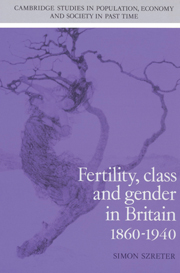Book contents
- Frontmatter
- Contents
- List of figures
- List of tables
- Acknowledgements
- List of abbreviations
- Introduction
- Part I Historiographical introduction: a genealogy of approaches
- Part II The professional model of social classes: an intellectual history
- Part III A new analysis of the 1911 census occupational fertility data
- 6 A test of the coherence of the professional model of class-differential fertility decline
- 7 Multiple fertility declines in Britain: occupational variation in completed fertility and nuptiality
- 8 How was fertility controlled? The spacing versus stopping debate and the culture of abstinence
- Part IV Conceptions and refutations
- Appendices
- Bibliography
- Index
- Cambridge Studies in Population, Economy and Society in the Past Time
7 - Multiple fertility declines in Britain: occupational variation in completed fertility and nuptiality
Published online by Cambridge University Press: 16 February 2010
- Frontmatter
- Contents
- List of figures
- List of tables
- Acknowledgements
- List of abbreviations
- Introduction
- Part I Historiographical introduction: a genealogy of approaches
- Part II The professional model of social classes: an intellectual history
- Part III A new analysis of the 1911 census occupational fertility data
- 6 A test of the coherence of the professional model of class-differential fertility decline
- 7 Multiple fertility declines in Britain: occupational variation in completed fertility and nuptiality
- 8 How was fertility controlled? The spacing versus stopping debate and the culture of abstinence
- Part IV Conceptions and refutations
- Appendices
- Bibliography
- Index
- Cambridge Studies in Population, Economy and Society in the Past Time
Summary
Introduction: an alternative grouping of occupations according to fertility behaviour
The previous chapter has demonstrated that the official endorsement of the professional model of social classes has resulted in the perpetuation of a misleading summary representation of the fertility evidence collected at the 1911 census. This chapter will attempt to re-evaluate the detailed evidence on occupational variation in the fertility of marriage. Supposing Stevenson and his contemporaries had not been so predisposed towards a classification and interpretation in terms of the professional model, what, if any, alternative social patterns could have been discerned from this enormous database?
In order to investigate the socio-demographic patterns of similarity and difference exhibited by the 195 available male occupational groupings, the same indices of completed fertility from the marriage cohort of the 1870s and 1880s will initially be deployed. Later in the chapter, additional dimensions of comparison will be introduced in the attempt to build up a fuller picture of the social, economic, political and cultural sources of variation in fertility behaviour which lie behind the occupational patterns presented in this first section. This additional information includes the extent to which each occupation was composed of employers, employees and the self-employed; the degree of variation in completed fertility exhibited by the younger-and older-marrying subsets within each occupation; divergences in marriage patterns between the occupations; and an exploration of the extent to which different forms of employment entailed relative segregation of the sexes in the workplace.
- Type
- Chapter
- Information
- Fertility, Class and Gender in Britain, 1860–1940 , pp. 310 - 366Publisher: Cambridge University PressPrint publication year: 1996



